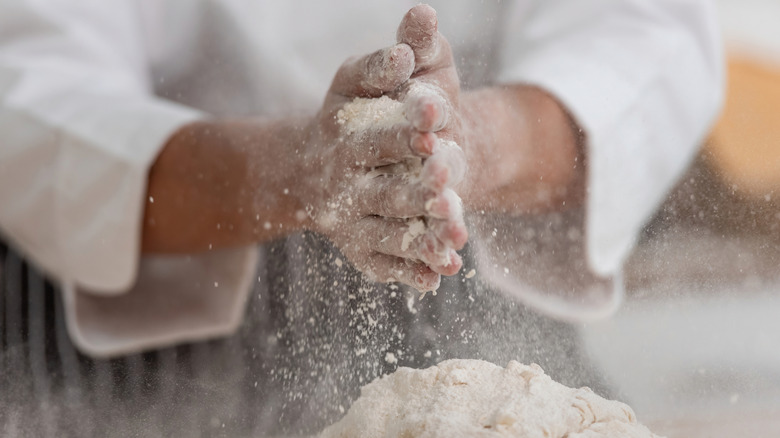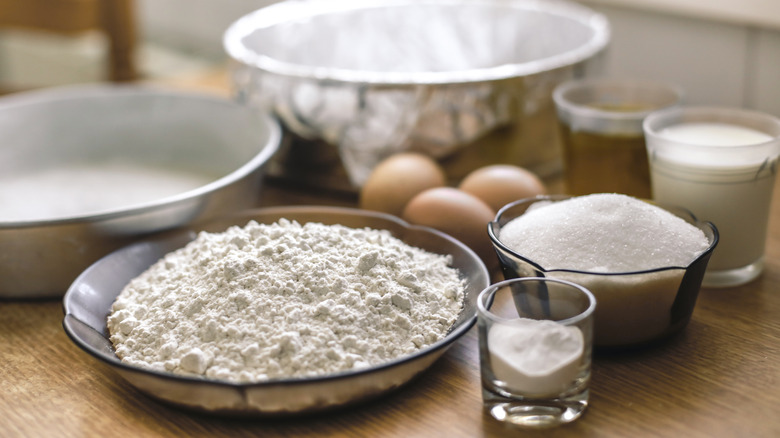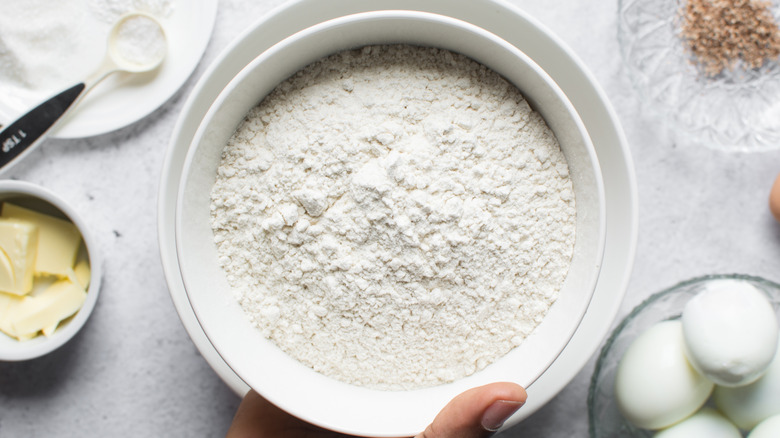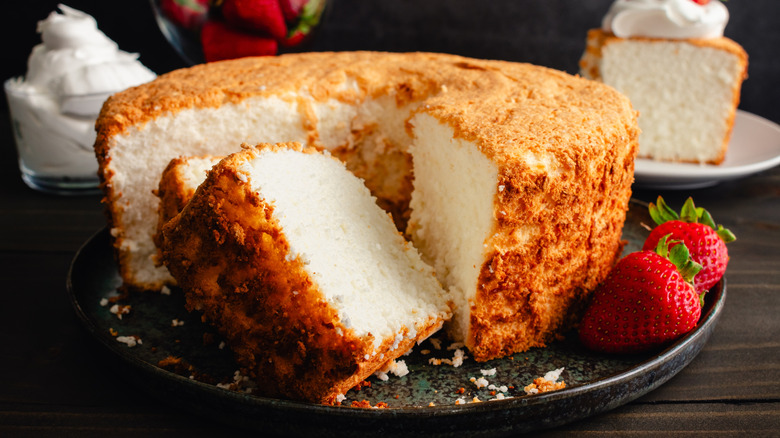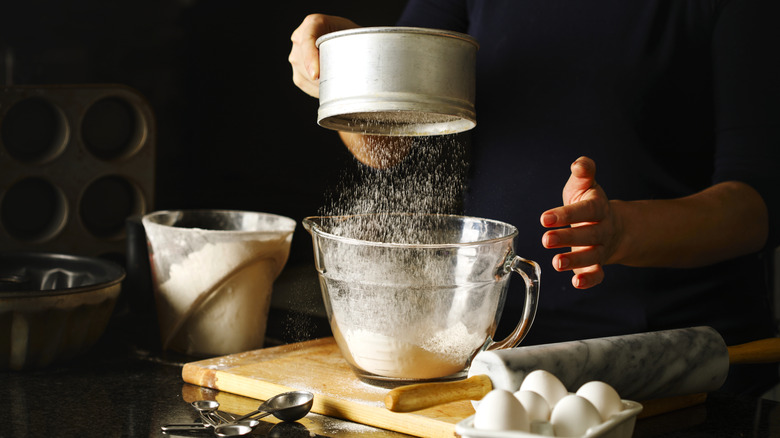The Key Difference Between Cake Flour And All-Purpose Flour
Flour is an intriguing substance. Defined as a grain crushed through the milling process, it encompasses many possible foodstuffs. In addition to the numerous wheat types — which range from semolina to pastry flour — alternative options like buckwheat, millet, and rice appear on store shelves.
As the central binder to baked goods, it's worth versing in the minutia, as the employed flour type has a strong impact. For example, say you're in the baking aisle of the grocery and eyeing grabbing either cake or all-purpose flour. The respective names offer some clues, but distinctions are blurry. It doesn't help that the packages are often alike, and visually, the flours look similar, too.
Yet their distinct starch and protein compositions impact their result. Cake flour is especially low in protein content, while high in starch. This leads to airier, more tender and moist textured baked goods. On the other hand, all-purpose flour possesses a slightly denser, more classic quality. Its higher protein quantity makes it functional enough to bake breads, but still delicate to craft pastries. And nevertheless, the two flours do share some similarities, since they're both neutral and made of wheat.
What is cake flour?
Cake flour is a processed wheat flour with a characteristic light consistency. Such a distinct composition occurs due to the milling of the grain's heart, which leads to fine individual kernels. Furthermore, the flour is subsequently bleached with chlorine, causing further decomposition. The resulting flour is snow-like in nature, with a texture of small particles clumped together.
Cake flour is one of the most delicate types, even finer than Dominique Ansel's pastry flour. With such a unique consistency, it's imperative to know how to use it. For instance, its lighter composition means a smaller weight, which affects the density. The flour more strongly bonds with eggs and other liquid, despite comprising less volume. This creates a thick, yet moist dough. Used properly, large cake-flour will remain soft, and biscuits turn out tender. As a result, the flour's composition leads to unique baking possibilities, more difficult with other types.
What is all-purpose flour?
All-purpose's name evinces its use: the flour's the most employed type. The product mixes several varieties, creating an average of many textures. Combining different granule sizes, as well as its protein contents, all-purpose offers great malleability. The flour offers a composition with durability that nonetheless fits many applications.
There's some variability among all-purpose flours. As opposed to cake flour, the variety is also available unbleached, a style that retains more of the grain characteristics. The bleached version has a slightly finer size, due to the use of chemicals during processing. However generally, the two all-purpose types are interchangeable.
All-purpose is a flour style that readily combines with fats and liquids, offering a foundation in bakes or thickening sauces. It's an effective base for roux, with the flour's flavor intensifying under heat. And simultaneously, all-purpose is a neutral enough binder to hold flour tortillas. So it comes as no surprise the flour's suitable for classic baked goods like cookies, cakes, breads, muffins, and pies.
The protein quantity of the flour influences the application
The central distinction between the two flour types is the protein content. Flours with more protein create a more elastic and sturdy dough. Especially once worked, a stronger network of gluten develops. This can be favorable in certain applications — like with bread — however detrimental in crafting more tender bakes. As a result, the protein composition strongly influences the use, but the precise protein quantity varies per product.
Cake flour contains some of the lowest protein composition among wheat-based varieties. At 6-10%, it's dependably lower than all-purpose, which fluctuates around 10-13%. Such a difference is sensed in the resultant bakes. Cake flour leads to a less sturdy, but more moist bake. It's the key foundation to a delightfully airy angel food cake, which pairs eggs whites and cream of tartar for easier creation. The flour also melds well with dairy creations, whether it's buttermilk, cream cheese, or a tres leches mix. And it's used to make a moist, perfect carrot cake or lend the crumble to a cookie or biscuit.
Meanwhile, the balanced protein content of all-purpose flour makes it extremely malleable. It's the foundation to classic cakes like chocolate or birthday, and a reliable choice for bread and cookie recipes. If there's a niche creation calling for flour — whether it's the breading on chicken fried steak or a set of wonton wrappers, all-purpose flour is fit for the job. That's all to say, you'll definitely want a batch of this foodstuff on hand.
All-purpose flour can be turned into cake flour
With cake flour's more obscure nature, no fear if you're out in a pinch. In certain applications, it is possible to swap the two, but keep in mind it'll impact the result. Similarly to how using bread flour versus all-purpose flour changes baked goods, a substitution isn't always perfect. It's especially unadvised to replace cake flour in recipes calling for all-purpose, as there won't be the necessary protein content. Unfortunately, it's too likely that the dough will likely turn out limp and flat.
On the other hand, it is possible to adjust all-purpose flour into cake flour with the help of corn starch. By switching 2 tablespoons per cup of flour for cornstarch, the protein content is more similar. Plus, the replacement compensates for the heavier weight and texture of all-purpose. So don't fret enough to stop the baking process, but keep in mind your utilized flour does make a difference.
